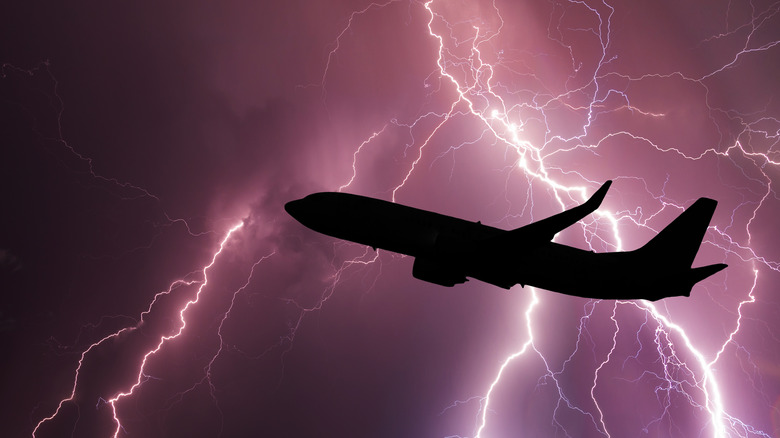What Are The Metal Rods On An Airplane's Wings Called And What Do They Do?
It could be said that the invention of the airplane is the ultimate triumph of mankind's ingenuity over the forces of nature. Despite our own lack of wings, we took to the skies and made it one of our primary means of travel. Nature, however, tends to be a bit vindictive at times. Even after we successfully got planes up in the air and figured out safe, long-distance air travel, there are always a few more curveballs nature can throw at us.
For example, consider the presence of electricity in the sky. We're not just talking about storms and thunderbolts; the mere movement of a plane through the air at high speed generates quite a bit of static electricity through friction. If that energy were left to run amok, it could hinder or damage a plane's vital electronic components, endangering passengers and crew. It's for this reason that modern airplanes are equipped with a vital element to safely intercept and disperse that ambient energy. For something so important, it's a deceptively low-profile piece of equipment: a handful of small metal rods on the wings known as static wicks.
Static electricity could interfere with an airplane's instruments
If a plane were flying through the sky on a completely clear, cloudless day, you would assume that there's nothing up there, right? But the thing we so often forget is that there's no such thing as "nothing," at least here on Earth. As the plane flies through the sky, it's constantly rushing and brushing through the atmosphere. In a small amount, this isn't noticeable, but that volume of air brushing past such a large construct at such high speeds will naturally start to generate electricity. Specifically, thanks to the phenomenon of friction, it generates static electricity, not unlike shuffling around a carpet in your socks.
An airplane is an exceptionally complex piece of machinery, but like anything powered by electricity, it only takes one quick jolt in the wrong place to set off a dangerous chain reaction. It's something anyone who's ever built a PC can attest to. If the static electricity from the atmosphere builds up in the plane, it can start to affect its various vital instruments like navigation equipment and communication radios. Transmissions could become disrupted, hindering or disabling a pilot's ability to communicate with Air Traffic Control. If a plane attempted to land in this state, the results could be potentially disastrous.
Static wicks capture electricity and safely disperse it
So, how is a plane supposed to protect itself from the threat of static discharge all the way up in the sky? As we mentioned, nature throws problems at us, but we've always managed to find solutions. The solution to this particular problem is a grounding system, an isolated path through which wild electricity can safely travel through and disperse back into the atmosphere. The linchpin to a plane's grounding system is the static wicks, small metal rods that dot the plane's wings where the most friction is generated.
As the plane flies and generates friction, the ensuing static electricity is captured by the static wicks, kind of like little lightning rods. The electricity travels through the static wicks, across the isolated grounding system, and back out the other end into the air, where it can safely dissipate away from the plane. Static wicks go a long way toward keeping a plane safe in flight, though they can start to fray with time, particularly from repeated exposure to the elements. This is why checking the static wicks is an important task on any aircraft upkeep checklist.


